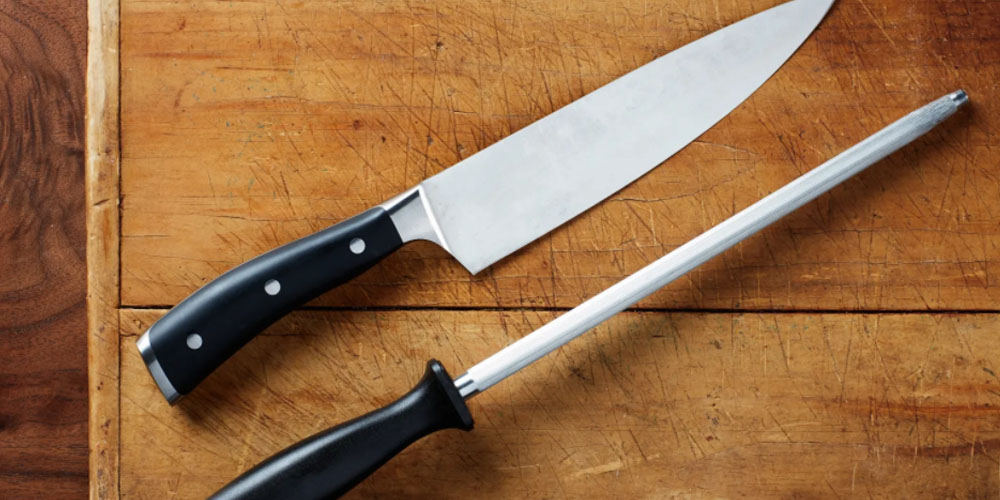It's essential to sharpen the knife if it's crushing tomatoes rather than slicing them or slipping when chopping onions. A sharp knife would provide uniformly sliced foodstuff, which would cook at a consistent rate. Knife sharpening is now a technique that every home cook must master; regardless you prefer using a manual or electrical sharpener or the whetstone.
The Advantages of Using a Sharp Knife
A Sharp knife will swiftly and accurately slice your veggies and chop up the meat. Knives that are kept sharp have two key advantages:
Safety
The safe knife is sharp. The dull knife is much more prone to slide and cut another thing, such as a finger.
Accuracy
The sharp knife allows for accurate cuts. The technique by which you slice the food influences how much time will it take to completely cook; it’s necessary to chop foodstuff into equal pieces so that it cooks simultaneously.
Three Knife Sharpening Techniques
The technique of sharpening the blade of a knife involves removing metal out of the blade for forming a razor-sharp edge. There are 3 methods for sharpening a knife on your own:
Manual sharpener
The easiest and cheapest method to sharpen your culinary knives is using a manual sharpener for the knife, commonly known as a pull-through knife sharpener. A manual sharpener for knives features two openings: coarse grit for sharpening and fine grit for polishing.
Electric sharpener
The fine and coarse opening on an electric sharpener is identical to those on the manual sharpener; however, the abrasives have been on the motorized wheels spinning opposite to the blade. Sharpening knives using an electric sharpener is far more effective and accurate than sharpening knives with a manual sharpener.
Whetstone
The whetstone is the rectangular stone having coarse grits on one side plus fine grits on the other. Sharpening a knife using a whetstone, also known as a sharpening stone, seems to be the most optimal way.
How to Sharpen Knives with a Manual Sharpener?
- Slide the knife 3 to 6 times over the coarse hole in the sharpener, starting from the heel then moving towards the tip, applying equal pressure.
- Finish by sliding it on fine grit hole 1 or 2 times.
How to Sharpen Knives using an Electric Sharpener?
- Slide the knife carefully and evenly over the slot, allowing the motorized abrasives to perform the task.
- Repeat the same step on the opposite side of the knife. Repeat same steps 3 to 6 times more if necessary.
- Now slide the knife on a fine grit hole, repeating the same steps.
- If the blades aren't sharp enough, continue the process until they are.
How to Sharpen Knives with a Whetstone?
Identify the accurate sharpening position for the knife before you start using a whetstone. The majority of knives must be sharpened at a 20 ° angle; however certain Japanese knives must be honed at a 15 ° angular position. If you're unsure, contact the knife's maker.
Before using the whetstone, lubricate it with a tiny quantity of honing oil or mineral oil.
- Soak the whetstone into the water till it is wet and there are no pockets of air left (it may take 5 to 10 minutes).
- Put the whetstone upon the counter, coarse side up. With the blade pointing opposite from you put the blade's edge on the stone at a proper sharpening angle.
- Put little pressure on the blade's flat side using one hand while gripping the handle with the other.
- Slide the knife's heel along the whetstone, maintaining the blade at a consistent angle, till the knife's tip runs off the stone's edge. Repeat this process 3 to 6 times more. It must feel like gliding motions in a circle. When you sharpen, keep an eye out on a burr that is a little piece of metal folding over the blade's edge.
- Repeat steps 3 and 4 upon the opposite end after the burr has formed over the whole knife's edge.
- Repeat steps 3 through 5 upon the fine grit end of the whetstone.
Key points on Knife Sharpening
- Knives should be sharpened on a regular basis. Even the finest knives would get rough over time if they are used often.
- A safe knife is one that is sharp. Knives must be kept sharp in order to slice the food with minimal slippage.
- Your dish will taste delicious if you use a very sharp knife. You want tiny pieces or small dice, neither huge nor ragged chunks. Precisely sliced food would cook at quite a consistent rate, resulting in a far more delicious meal.


